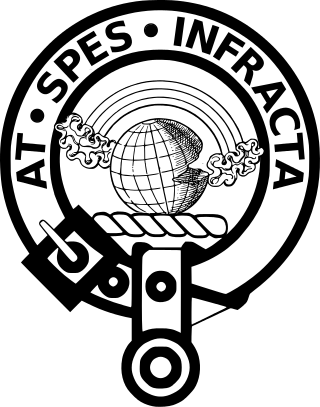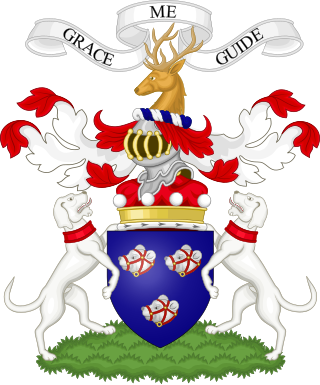
Clan Campbell is a Highland Scottish clan, historically one of the largest and most powerful of the Highland clans. The Clan Campbell lands are in Argyll and within their lands lies Ben Cruachan. The chief of the clan became Earl of Argyll and later Duke of Argyll.

Lord Torphichen or Baron Torphichen is a title in the Peerage of Scotland. It was created by Queen Mary in 1564 for Sir James Sandilands, with remainder to his heirs and assigns whatsoever. John Horne Stevenson, Marchmont Herald, wrote in “Dignities” That the barony of Torphichen was the only possible exception to the general rule that peerages cannot be transmitted and must be inherited.

Clan Scott is a Scottish clan and is recognised as such by the Lord Lyon King of Arms. Historically the clan was based in the Scottish Borders.

Torphichen Preceptory is a church in the village of Torphichen, West Lothian, Scotland. It comprises the remains of the preceptory (headquarters) of the Knights Hospitaller of the Order of St John of Jerusalem in Scotland. The placename may be Gaelic in origin, e.g., "Tóir Féichín" or Brythonic, e.g., modern Welsh "tref fechan". The name "Tóir Féichín" with its Gaelic reference to the Boundary/Sanctuary stones set one mile around the village is most likely the true meaning of the village and Preceptory name rather than the modern Welsh which has no historical precedent that overrides the true meaning of those Neolithic sanctuary stones.

Clan Sinclair is a Highland Scottish clan which holds the lands of Caithness, the Orkney Islands, and the Lothians. The chiefs of the clan were the Barons of Roslin and later the Earls of Orkney and Earls of Caithness.

Mid Calder is a village in West Lothian, Scotland. It is located on a steep hill overlooking the River Almond and Calder Wood, around 15 miles (24 km) west of Edinburgh. The settlement has been on a major crossroads since its origin some time in the 11th century.

Clan Carnegie is a Lowland Scottish clan.

Clan Dunbar is a Scottish clan of the Scottish Lowlands.

Clan Home is a Scottish clan. It held immense power for much of the Middle Ages and dominated the eastern Scottish Borders. It produced no fewer than eight Wardens of the Eastern March – more than any other family.

Clan Lindsay is a Scottish clan of the Scottish Lowlands.

Clan MacDowall or MacDouall is a Lowlands Scottish clan.

Clan Oliphant is a Highland Scottish clan.

Clan Hope is a Scottish clan of the Scottish Lowlands.

Clan Primrose is a Lowland Scottish clan.

Clan Marjoribanks is a Scottish clan of the Scottish Lowlands.
James Sandilands was a Scottish nobleman. He was the second son of Sir James Sandilands, 7th Lord of Calder. The feudal barony of Calder had belonged to the Sandilands family since 1348.

Clan Crawford is a Scottish clan of the Scottish Lowlands. The clan is of Scandinavian and Anglo-Saxon origin. There was in the early 18th century a mistaken belief that the clan had Norman origins. While historically recognised as a clan by the Court of the Lord Lyon, it is now an armigerous clan as it no longer has a chief. The last chief was Hugh Ronald George Craufurd, who sold his land and moved to Canada in 1904. He died in Calgary in 1942, leaving no male heirs.

Clan Forbes is a Highland Scottish clan from Aberdeenshire, Scotland.
James Sandilands, 7th Lord Torphichen was a Scottish nobleman and army officer, a loyalist of the 1715 Jacobite Rebellion.

Calder House is a historic Scottish country house in Mid Calder, Scotland, the family seat of the Sandilands family since 1348, and deemed to be one of the great Renaissance houses of Scotland.



















